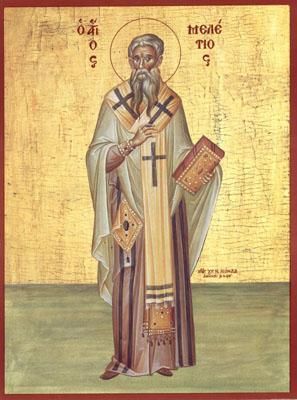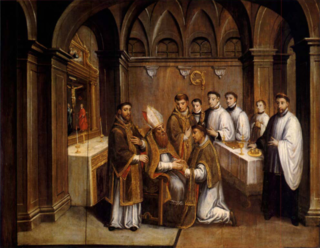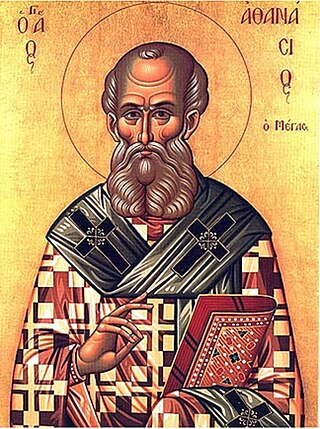Eusebius of Nicomedia was an Arian priest who baptized Constantine the Great on his deathbed in 337. A fifth-century legend evolved that Pope Sylvester I was the one to baptize Constantine, but this is dismissed by scholars as a forgery 'to amend the historical memory of the Arian baptism that the emperor received at the end of his life, and instead to attribute an unequivocally orthodox baptism to him.' He was a bishop of Berytus in Phoenicia. He was later made the bishop of Nicomedia, where the Imperial court resided. He lived finally in Constantinople from 338 up to his death.

The First Council of Nicaea was a council of Christian bishops convened in the Bithynian city of Nicaea by the Roman Emperor Constantine I. The Council of Nicaea met from May until the end of July 325.

The First Council of Constantinople was a council of Christian bishops convened in Constantinople in AD 381 by the Roman Emperor Theodosius I. This second ecumenical council, an effort to attain consensus in the church through an assembly representing all of Christendom, except for the Western Church, confirmed the Nicene Creed, expanding the doctrine thereof to produce the Niceno-Constantinopolitan Creed, and dealt with sundry other matters. It met from May to July 381 in the Church of Hagia Irene and was affirmed as ecumenical in 451 at the Council of Chalcedon.

Saint Meletius was a Christian bishop of Antioch from 360 until his death in 381. However, his episcopate was dominated by a schism, usually called the Meletian schism.

Arius was a Cyrenaic presbyter, ascetic, and priest. Traditionally, it was claimed that Arius was the founder of the doctrine of Arianism but, more recently, Rowan Williams stated that "Arius' role in 'Arianism' was not that of the founder of a sect. It was not his individual teaching that dominated the mid-century eastern Church."
The Acacians, or perhaps better described as the Homoians or Homoeans, were a non-Nicene branch of Christianity that dominated the church during much of the fourth-century Arian Controversy. They declared that the Son was similar to God the Father, without reference to substance (essence). Homoians played a major role in the Christianization of the Goths in the Danubian provinces of the Roman Empire.
In 294 AD, Sirmium was proclaimed one of four capitals of the Roman Empire. The Councils of Sirmium were the five episcopal councils held in Sirmium in 347, 351, 357, 358 and finally in 375 or 378. In the traditional account of the Arian Controversy, the Western Church always defended the Nicene Creed. However, at the third council in 357—the most important of these councils—the Western bishops of the Christian church produced an 'Arian' Creed, known as the Second Sirmian Creed. At least two of the other councils also dealt primarily with the Arian controversy. All of these councils were held under the rule of Constantius II, who was eager to unite the church within the framework of the Eusebian Homoianism that was so influential in the east.
Acacius of Caesarea was a Christian bishop probably originating from Syria; Acacius was the pupil and biographer of Eusebius and his successor on the see of Caesarea Palestina. Acacius is remembered chiefly for his bitter opposition to Cyril of Jerusalem and for the part he was afterwards enabled to play in the more acute stages of the Arian controversy. The Acacian theological movement is named after him. In the twenty-first oration of St. Gregory Nazianzen, the author speaks of Acacius as being "the tongue of the Arians".
Semi-Arianism was a position regarding the relationship between God the Father and the Son of God, adopted by some 4th-century Christians. Though the doctrine modified the teachings of Arianism, it still rejected the doctrine that Father, Son, and Holy Spirit are co-eternal, and of the same substance, or consubstantial, and was therefore considered to be heretical by many contemporary Christians.
Marcellus of Ancyra was a Bishop of Ancyra and one of the bishops present at the Council of Ancyra and the First Council of Nicaea. He was a strong opponent of Arianism, but was accused of adopting the opposite extreme of modified Sabellianism. He was condemned by a council of his enemies and expelled from his see, though he was able to return there to live quietly with a small congregation in the last years of his life. He is also said to have destroyed the temple of Zeus Belos at Apamea.
George was the bishop of Laodicea in Syria from 335 until his deposition in 347. He took part in the Trinitarian controversies of the fourth century. At first an ardent admirer of the teaching of Arius and associated with Eusebius of Nicomedia, he subsequently became a semi-Arian, but seems ultimately to have united with the Anomoeans, whose uncompromising opponent he had once been, and to have died professing their tenets.
Beginning with three synods convened between 264 and 269 in the matter of Paul of Samosata, more than thirty councils were held in Antioch in ancient times. Most of these dealt with phases of the Arian and of the Christological controversies. For example, the Catholic Encyclopedia article on Paul of Samosata states:
It must be regarded as certain that the council which condemned Paul rejected the term homoousios; but naturally only in a false sense used by Paul; not, it seems because he meant by it a unity of Hypostasis in the Trinity, but because he intended by it a common substance out of which both Father and Son proceeded, or which it divided between them, — so St. Basil and St. Athanasius; but the question is not clear. The objectors to the Nicene doctrine in the fourth century made copious use of this disapproval of the Nicene word by a famous council.
Hypostasis, from the Greek ὑπόστασις (hypóstasis), is the underlying state or underlying substance and is the fundamental reality that supports all else. But it is not the same as the concept of a substance. In Neoplatonism the hypostasis of the soul, the intellect (nous) and "the one" was addressed by Plotinus. In Christian theology, the Holy Trinity consists of three hypostases: Hypostasis of the Father, Hypostasis of the Son, and Hypostasis of the Holy Spirit.
Homoiousios is a Christian theological term, coined in the 4th century to identify a distinct group of Christian theologians who held the belief that God the Son was of a similar, but not identical, essence with God the Father.
The Council of Serdica, or Synod of Serdica, was a synod convened in 343 at Serdica in the civil diocese of Dacia, by Emperors Constans I, Augustus in the West, and Constantius II, Augustus in the East. It attempted to resolve "the tension between East and West in the Church." “The council was a disaster: the two sides, one from the west and the other from the east, never met as one.”
The Arian controversy was a series of Christian disputes about the nature of Christ that began with a dispute between Arius and Athanasius of Alexandria, two Christian theologians from Alexandria, Egypt. The most important of these controversies concerned the relationship between the substance of God the Father and the substance of His Son.

Paulinus II was a claimant to the See of Antioch from 362 to 388.
Arian creeds are the creeds of Arian Christians, developed mostly in the fourth century when Arianism was one of the main varieties of Christianity.
Theodotus was the bishop of Laodicea in Syria from the early 300s. He replaced Stephen, who apostasized during the Great Persecution (303–313). The exact year of his consecration cannot be fixed more precisely. He attended at least four church councils.

Tomus ad Antiochenos is a letter or mediation proposal written by Bishop Athanasius of Alexandria on behalf of a regional synod he convened in Alexandria in 362, addressed to a group of bishops seeking a solution to the schism between "Eustathians" and "Meletians" in the parishes of Antioch. This letter played a key role in the Trinitarian theological debates between the one-hypostasis model and the three-hypostasis model of the Trinity, anticipating the turning point in this question from the 370s onward.






